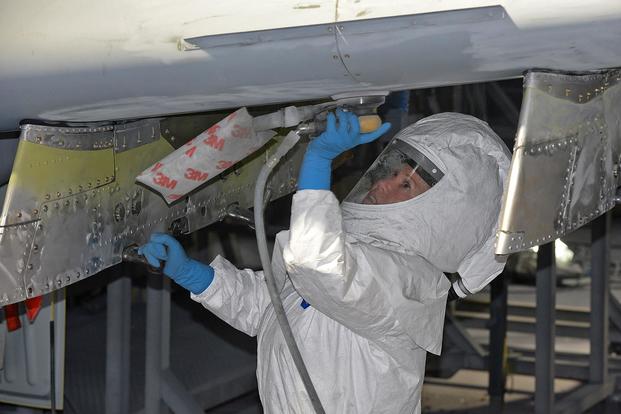The U.S. Air Force has completed a re-winging effort for 173 A-10 Warthog attack aircraft that began nearly a decade ago.
As part of the $1.1 billion "Enhanced Wing Assembly" contract awarded to Boeing Co. in 2007, the Ogden Air Logistics Complex at Hill Air Force Base, Utah, recently completed work on the last A-10 slated to receive the upgrade, the service said in a news release Monday. The effort began in 2011.
The new wings will give the A-10s a longer life span. They are expected "to last for up to 10,000 equivalent flight hours without a depot inspection," which should take them well into the 2030s, according to the release.
"From a warfighter point of view, bringing this program to a successful conclusion was a significant accomplishment for the entire enterprise team," said Stephen Zaiser, 571st Aircraft Maintenance Squadron director at Ogden. Ogden maintainers swapped out wings on 162 aircraft; the rest were completed at Osan Air Base, South Korea, the release states.
Related content:
- Air Force Gearing Up for Next A-10 Re-Winging Contract
- 'Saving Guys on the Ground': A-10 Documentary Shows Stunning Mission
- Air Force Debates Replacing Depleted Uranium Rounds for A-10
The conclusion of this contract comes as the service prepares for another A-10 contract to re-wing more of the close-air support aircraft.
The contract for the "A-10-Thunderbolt II Advanced-Wing Continuation Kit," known as "ATTACK," is expected to be awarded this fall, Air Force spokeswoman Ann Stefanek told Military.com in April.
The service has $267 million set aside to buy "about 20 total wings," she said at the time.
The Air Force in 2018 said it had begun searching for a new company to rebuild wings for the A-10 after ending its arrangement with Boeing, though officials have not committed to re-winging the entire fleet.
The service has 281 Warthogs in its inventory, but so far has committed to maintaining wings for only six of its nine A-10 combat squadrons through roughly 2032, unless additional funding becomes available.
Still, the popular aircraft has come a long way.
The planes, which entered service in 1976 and have deployed to the Middle East, Europe and the Pacific, have played an outsized role in the air campaign that began in 2014 against the Islamic State of Iraq and Syria, or ISIS, helping provide close-air support for Iraqi and U.S. partner forces on the ground. The same applies to operations in Afghanistan.
(A-10 fans describe the distinctive sound its seven-barrel 30mm GAU-8 Avenger rotary cannon makes when firing as "brrrt.")
The conversation to retire the aircraft began in 2014 by top brass who said the Warthog might not be survivable in a future fight. And following budget cuts known as sequestration, officials said maintaining the single-mission aircraft had become expensive at a time when the Defense Department was looking for more variety from its platforms.
In 2016, then-Defense Secretary Ash Carter announced that the A-10's retirement would be delayed until 2022 after lawmakers complained that eliminating it would deprive the military of a "valuable and effective" close-air-support aircraft. However, fiscal 2017 budget request documents showed the Air Force still planned to remove A-10 squadrons in increments between 2018 and 2022 to make room for F-35A Lightning II squadrons coming online.
After more congressional pushback to keep the A-10 flying for as long as possible to keep troops secure on the ground, then-Air Force Materiel Command chief Gen. Ellen Pawlikowski said in October 2016 that the Warthog depot line was cranking back up as part of an effort to keep the Cold War-era aircraft flying "indefinitely."
In the service's latest news release, Michael Hackett, A-10 Special Program Office chief engineer, said that his office, in partnership with the Ogden ALC, "is poised to keep the aircraft flying for the foreseeable future."
-- Oriana Pawlyk can be reached at oriana.pawlyk@military.com. Follow her on Twitter at @Oriana0214.












